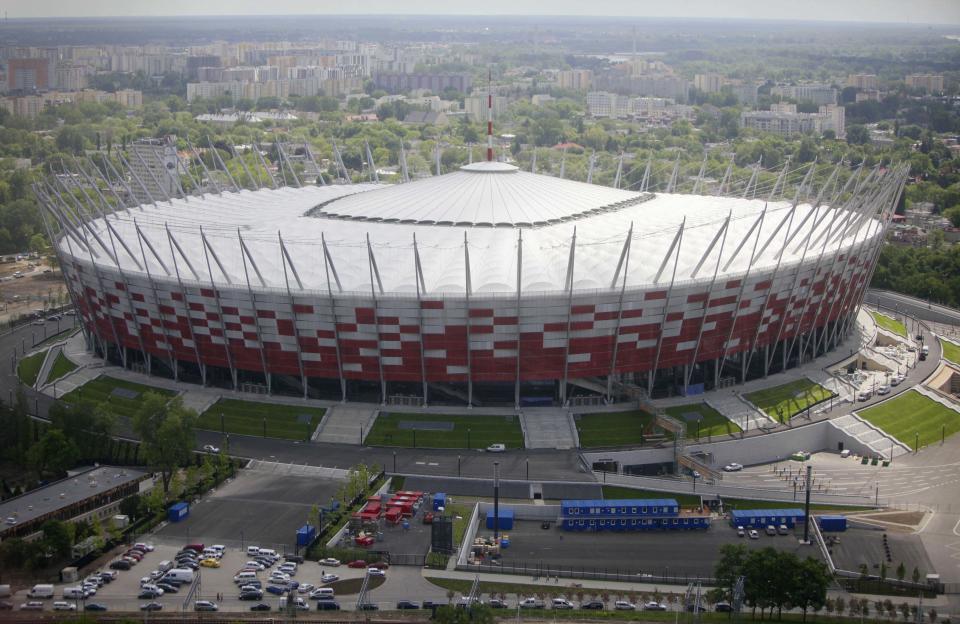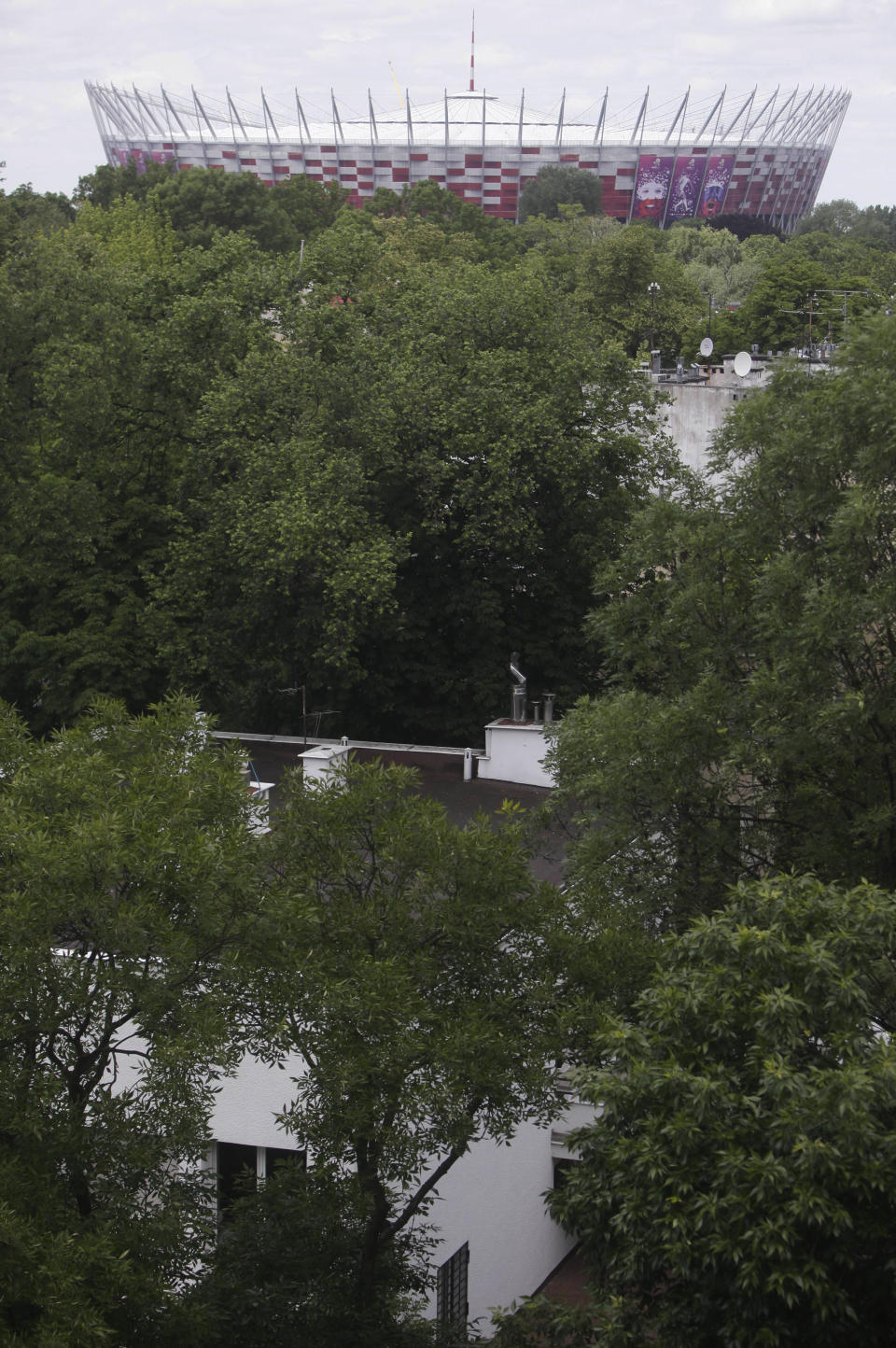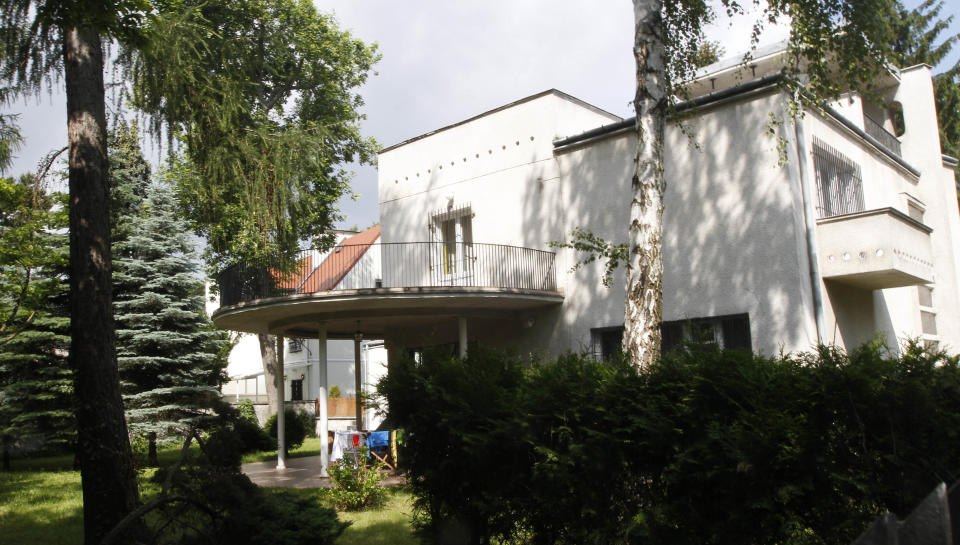Warsaw stadium adds new threat to historic area
WARSAW, Poland (AP) — The National Stadium in Poland, built for the 2012 European Championship, rises in the shape of a wicker basket over one of Warsaw's most popular neighborhoods: Saska Kepa, an enclave of towering trees and architectural gems dating back to the 1920s.
To some, the colossal stadium — with a retractable fiberglass roof and a shimmery red-and-white facade in the colors of the national flag — is a source of pride, a symbol of a capitalist surge that has remade the country since it threw off communism in 1989.
To others, the 58,000-seat arena is an eyesore and the latest affront to a unique neighborhood already threatened by a rising class of entrepreneurs and developers. Proof, if any more was needed, of how breakneck economic growth can jeopardize a vulnerable architectural heritage.
"It's like a big giant UFO that landed nearby," complains Marcin Eckert, a 40-year-old tax lawyer whose view at breakfast is now dominated by the stadium. Says his wife, Dorota Jurkiewicz-Eckert: "We feel we have been squashed by an elephant."
Any change to historic areas in Warsaw provokes strong emotions because of how little survived World War II. Saska Kepa, an exclusive area before the war that was home to doctors and lawyers and other upper middle-class professionals, has the unique distinction of being the city's only prestigious neighborhood to survive in its entirety.
But it's been under attack ever since.
During communism, several unsightly apartment blocks went up across the neighborhood, built by people who "did not understand the meaning and beauty of the place," said Marta Lesniakowska, a historian of architecture with the Polish Academy of Sciences.
Capitalism hasn't been kind either. A spectacular modernist villa built in 1929 was torn down to widen a road. A square, Plac Przymierza, disappeared under a complex of apartments and shops that dwarf surrounding homes. Now developers are busy dismantling or radically restructuring prewar homes to build much larger structures — changes that erode their historic look and swallow up leafy plots that long gave the area a distinctive garden city feel.
"This is not the Saska Kepa of my childhood," says Jurkiewicz-Eckert, a 40-year-old art historian. She and her husband are members of a group trying to preserve the neighborhood, Zielona Saska Kepa — meaning Green Saska Kepa. "We are on the way to losing the old-fashioned atmosphere of the place. And it's because of the greed of the developers."
Saska Kepa — where maple, ash and linden trees give shade to prewar homes and trendy restaurants — has the unusual distinction of surviving the war in its entirety because of its location on the eastern bank of the Vistula River, where Soviet troops sat idly during the 1944 Warsaw Uprising against the occupying German forces. Polish insurgents hoped for the support of the Red Army, which by that time had made it to Warsaw in its westward push that defeated Hitler. But Soviet leader Joseph Stalin preferred to let the Germans destroy the city and its people, knowing they would have also become a democratic opposition to Moscow's postwar domination.
Hitler's forces, in retribution for the revolt, razed most of the city to the ground. During the decades of Soviet control that followed, the capital was rebuilt in a gray and heavy Stalinist style that is still predominant. Over the past two decades the city has been transformed again by glass-skinned skyscrapers.
Despite its architectural decline, Saska Kepa boasts some of the most expensive real estate in the city of 1.7 million people. The city center is only a couple of tram stops away across the river, yet a small-town residential stillness reigns over its smaller streets, quiet but for the sound of birds and dogs, the air in spring fragrant with lilacs.
Streets are lined with embassies and family homes, some built in the style of classical Polish manor houses and others in the modernist Bauhaus style pioneered by Le Corbusier and Walter Gropius. It is one that is simple, boxy and restrained but for the odd bit of whimsy: a curved outdoor staircase here, circular submarine-style windows there.
Elsewhere the style is celebrated: in Germany, where it arose in 1919; in Tel Aviv, where Jews who fled Europe in the 1930s made their architectural mark; in the Czech city of Brno, where the recently renovated Villa Tugendhat of Ludwig Mies van der Rohe is an iconic example of modernism. The villa and Tel Aviv's modernist buildings have been declared world heritage sites by UNESCO.
Yet the simple modernist style of usually white or gray homes isn't always valued in Poland. Sometimes their understated beauty doesn't come through because they are rundown, their owners unable to afford restoration work. It also doesn't help that the modernist buildings have an architectural austerity that reminds some of the also simple but bleaker style favored by the communists.
"People were starved through the communist period of detail and color," said Lidia Polubiec, an art historian and local resident trying to protect the neighborhood. "Often they don't understand the value of simplicity."
Polubiec has witnessed residents throwing away decades-old oak doors and beautiful brass door handles that are in bad shape, replacing them with cheap modern fixtures rather than trying to salvage the old ones. She is also fighting a wave of homes being repainted in "fruit- and yogurt-colored pinks, buttery yellows, greens — colors totally unsuited to the area and style of the buildings."
Barbara Jezierska, a conservation official in the Warsaw region until last year, says the devastation of historic homes is happening across the city and beyond.
She has witnessed wealthy Poles buying historic homes in older neighborhoods and then tearing them down to build larger modern homes. Sometimes homes burn down mysteriously after owners are denied permission to alter historically protected structures — leaving them then free to proceed.
"Hitler began ruining this city, then Stalin took over and now the Poles are doing it," Jezierska said bitterly.
Lesniakowska said part of the problem, aside from a general lack of respect for "refined" architecture, is that although Saska Kepa has been designated a historic district, not all individual buildings are protected.
Warsaw's modernist homes are a testament to a Jewish world that was wiped out during the Holocaust. Many of the original owners and their architects were Jewish. One, Maksymilian Goldberg, designed several family homes in Saska Kepa before he perished in the Warsaw Ghetto in 1942. Another, Lucjan Korngold, fled early enough and ended up in Brazil, where he designed buildings in Sao Paolo.
"By destroying Saska Kepa, the developers are also destroying a part of Poland's Jewish history," said Katarzyna Shannon, 44, a resident and a co-founder of Zielona Saska Kepa. She walks her dog regularly along its streets, keeping her eye out for signs of construction work — vigilance that has helped stop the transformation of a couple of homes.





